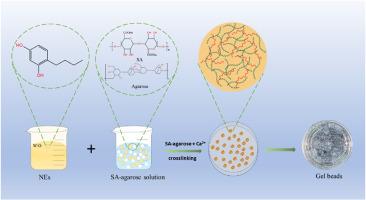Fabrication, characterization and transdermal properties of double cross-linked gel beads with 4-n-butylresorcinol
European Journal of Medicinal Chemistry Reports
Pub Date : 2024-10-18
DOI:10.1016/j.ejmcr.2024.100232
引用次数: 0
Abstract
In this paper, sodium alginate (SA) -agarose double cross-linked gel beads were prepared to improve the solubility of 4-n-butylresorcinol and to reduce skin irritation. The wrappage material suitable for 4-nBR gel beads was SA-agarose double cross-linking material, and the internal inclusions were in the form of 4-n-butylresorcinol nanoemulsions (4-nBR NEs). Under the orthogonal fluorescence microscope, it was observed that the gel beads were spherical in shape, with smooth and rounded surfaces and permeable interiors. The encapsulation rate of the gel beads was 84.37 ± 3.56 %, and the average diameter was 1.93 ± 0.21 mm. Scanning electron microscopy showed that the gel beads were spherical in shape. The cumulative leakage rate of the gel beads on the 35 th day was 4.72 ± 0.06 %, suggesting that the gel beads encapsulated 4-butylresorcinol to good effect and with high stability. This proves that the gel beads wrapped with 4-nBR are highly effective and stable. In vitro skin permeability assessment verified the good skin permeability of nanoemulsions (NEs).

含有 4-正丁基间苯二酚的双交联凝胶珠的制造、表征和透皮特性
本文制备了海藻酸钠(SA)-琼脂糖双交联凝胶珠,以提高 4-正丁基间苯二酚的溶解度并减少对皮肤的刺激。4-丁基间苯二酚凝胶珠的包裹材料为海藻酸钠-琼脂糖双交联材料,内含物为4-丁基间苯二酚纳米乳液(4-nBR NEs)。在正交荧光显微镜下观察到,凝胶珠呈球形,表面光滑圆润,内部可渗透。凝胶珠的封装率为 84.37 ± 3.56%,平均直径为 1.93 ± 0.21 毫米。扫描电子显微镜显示凝胶珠呈球形。凝胶珠在第 35 天的累积泄漏率为 4.72 ± 0.06 %,这表明凝胶珠封装 4-丁基间苯二酚的效果良好,稳定性高。这证明了用 4-丁苯橡胶包裹的凝胶珠是高效和稳定的。体外皮肤渗透性评估验证了纳米乳液(NEs)良好的皮肤渗透性。
本文章由计算机程序翻译,如有差异,请以英文原文为准。
求助全文
约1分钟内获得全文
求助全文

 求助内容:
求助内容: 应助结果提醒方式:
应助结果提醒方式:


